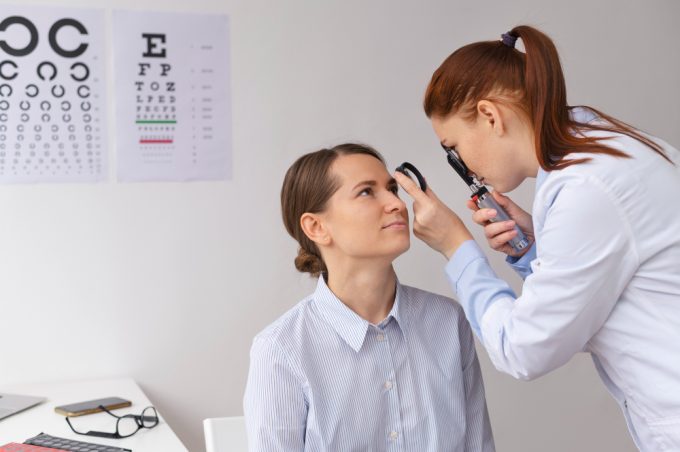Learn what to expect when visiting the Emergency Department. Learn More
-
CALL: +971 4 3454040

- Medical Technology
- July 7, 2025
- 5 MINS READ
Introduction: Why Eye Health Deserves Your Attention
Your eyes are not just the windows to the world—they are also intricate, sensitive organs that require consistent care and timely attention. In today’s fast-paced digital age, where screen time is at an all-time high and environmental stressors are ever-increasing, maintaining optimal eye health has become more crucial than ever. Fortunately, understanding Common Eye Conditions and how ophthalmologists manage them can empower individuals to seek the right care before minor issues escalate into serious vision problems.
What Are Common Eye Conditions?
To begin with, Common Eye Conditions are a group of visual impairments or disorders that affect a large portion of the population. These may range from refractive errors to chronic diseases that demand long-term management. While some conditions are minor and easily treatable, others require surgical intervention and regular monitoring.
Let’s explore some of the most frequently diagnosed Common Eye Conditions in both adults and children.
1. Refractive Errors: The Most Widespread Vision Issues
Refractive errors occur when the shape of your eye prevents light from focusing directly on the retina. These include:
-
Myopia (Nearsightedness) – Difficulty seeing distant objects
-
Hyperopia (Farsightedness) – Trouble focusing on nearby objects
-
Astigmatism – Blurred vision due to irregular corneal curvature
-
Presbyopia – Age-related difficulty in seeing things up close
These Common Eye Conditions are generally corrected through:
-
Prescription glasses or contact lenses
-
Refractive surgeries such as LASIK or PRK
-
Vision therapy in some pediatric cases
Ophthalmologists usually start with a comprehensive eye exam to assess the severity of the refractive error before deciding on the appropriate treatment plan.
2. Cataracts: A Cloud Over Clarity
Cataracts occur when the eye’s natural lens becomes cloudy, leading to blurry vision and sensitivity to light. While cataracts are typically age-related, they can also result from trauma, medication side effects, or underlying health conditions like diabetes.
Key symptoms include:
-
Cloudy or dim vision
-
Increased glare and halos around lights
-
Poor night vision
-
Frequent prescription changes
The most effective treatment is cataract surgery, where the cloudy lens is replaced with a clear artificial one. This procedure is safe, and quick, and offers almost immediate improvement in vision.
3. Glaucoma: The Silent Thief of Sight
Glaucoma is a serious eye condition characterized by increased intraocular pressure that damages the optic nerve. It often progresses without noticeable symptoms until significant vision loss occurs—hence the nickname “the silent thief of sight.”
There are different types of glaucoma, but they all require prompt diagnosis and consistent treatment to prevent permanent damage. Management typically includes:
-
Prescription eye drops to lower eye pressure
-
Oral medications
-
Laser therapy or surgery in advanced cases
Routine screenings are vital for early detection, especially for individuals over 40 or those with a family history of glaucoma.
4. Dry Eye Syndrome: More Than Just Irritation
This common yet often overlooked condition occurs when your eyes don’t produce enough tears or when the tears evaporate too quickly. Though it may sound minor, chronic dry eye can significantly impact your quality of life.
Symptoms include:
-
Stinging or burning sensation
-
Redness and irritation
-
Sensitivity to light
-
Feeling like something is in the eye
Treatment options vary depending on the severity, ranging from artificial tear drops to specialized procedures like punctual plugs or LipiFlow therapy.
5. Age-Related Macular Degeneration (AMD)
This condition affects the macula—the part of the retina responsible for sharp central vision. AMD is a leading cause of vision loss in older adults and exists in two forms: dry and wet.
While dry AMD progresses slowly, wet AMD can cause rapid vision loss. Although there’s no cure, treatment includes:
-
Anti-VEGF injections for wet AMD
-
Nutritional supplements to slow progression
-
Low vision aids and lifestyle modifications
Because AMD can dramatically affect daily tasks such as reading and driving, early intervention is key.
6. Diabetic Retinopathy: A Threat to Diabetic Eyes
People with diabetes are at risk for developing diabetic retinopathy, a condition caused by damage to the blood vessels in the retina. Left untreated, it can lead to blindness.
Warning signs may include:
-
Floaters or dark spots
-
Fluctuating vision
-
Impaired color perception
-
Vision loss in advanced stages
Ophthalmologists often recommend regular dilated eye exams for diabetics. Treatment may include laser therapy, anti-VEGF injections, or vitrectomy surgery in severe cases.
How Ophthalmologists Diagnose and Treat These Conditions
Ophthalmologists use a range of diagnostic tools to detect Common Eye Conditions early and accurately:
-
Comprehensive eye exams
-
Tonometry to check eye pressure
-
Optical coherence tomography (OCT) for detailed imaging
-
Visual field tests
After diagnosis, treatment strategies are customized to each patient’s condition, age, and lifestyle. The ultimate goal is to preserve vision, prevent further damage, and enhance the patient’s overall eye health.
Tips for Maintaining Good Eye Health
Taking a proactive approach can prevent or slow the progression of many Common Eye Conditions. Here’s how:
-
Schedule annual eye exams
-
Eat a balanced diet rich in omega-3s and antioxidants
-
Wear UV-protected sunglasses outdoors
-
Follow the 20-20-20 rule when using screens
-
Control chronic conditions like diabetes and hypertension
-
Avoid smoking, as it accelerates eye degeneration
Conclusion: Take the Next Step Toward Better Vision
In summary, early detection and timely treatment of Common Eye Conditions can prevent serious complications and preserve your vision for years to come. Whether you’re experiencing symptoms or simply wish to stay on top of your eye health, seeking professional care is always a wise decision.
For those seeking expert care, the best ophthalmologist in Dubai offers advanced diagnostic and treatment options. At the Medical Specialists Center, patients benefit from a team of skilled eye doctors and professionals dedicated to personalized, world-class ophthalmic care. Whether you’re searching for an optometrist near me, a trusted eye doctor, or top-tier ophthalmology in Dubai, our clinic ensures expert vision care. Visit us to consult the leading optometrist in Dubai today.



